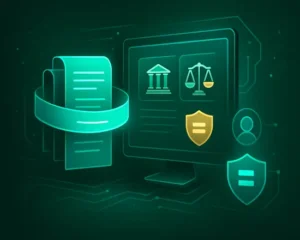As artificial intelligence becomes central to digital transformation strategies, governments, industries, and civil society have called for clear standards to ensure responsible, safe, and ethical AI. In response, the International Organization for Standardization (ISO) and International Electrotechnical Commission (IEC) published ISO/IEC 42001:2023, the first certifiable global standard specifically designed for AI management systems.
ISO 42001 sets out a comprehensive framework for establishing, implementing, maintaining, and improving an AI Management System (AIMS). It offers guidance across the full lifecycle of AI systems—from design and data sourcing to deployment, monitoring, and retirement—while emphasizing transparency, fairness, accountability, and human oversight.
This blog post explains the key components of ISO/IEC 42001 and shows how the Pacific AI Governance Policy Suite — a free, modular set of AI policies updated quarterly—provides full coverage of the standard’s requirements. For each clause of ISO 42001, we provide a detailed mapping to the Pacific AI policies and the specific sections that address the control.
What Is ISO/IEC 42001?
ISO/IEC 42001:2023 is the first international management system standard for AI. Like ISO 27001 for cybersecurity or ISO 9001 for quality management, ISO 42001 is certifiable—meaning organizations can be formally audited and certified for compliance.
It covers the following key areas:
- Organizational context
- Leadership and accountability
- Planning and risk management
- Support (resources, skills, documentation)
- Operational controls across the AI lifecycle
- Monitoring and continuous improvement
ISO 42001 is designed to be flexible: it applies to organizations of all sizes and industries and works alongside other standards like ISO 31000 (risk management), ISO 27001 (information security), and ISO 37301 (compliance management).
Mapping ISO/IEC 42001 Controls to the Pacific AI Policy Suite
Below is a control-by-control mapping of ISO 42001 requirements to the Pacific AI Governance Policy Suite. Each entry includes:
- A brief description of the ISO control
- The Pacific AI policy that addresses it
- The specific clause that fulfills the requirement
| ISO 42001 Control Description | Pacific AI Policy | Clause |
|---|---|---|
| Understanding organizational context and stakeholders | AI Risk Management Policy | §3, §4.4 |
| Establishing an AI governance framework | AI Risk Management Policy | §3, §9 |
| Defining AI system roles and responsibilities | AI System Lifecycle Policy | §3 |
| Risk identification and mitigation planning | AI Risk Management Policy | §4-6 |
| Lifecycle oversight and risk classification | AI System Lifecycle Policy | §4-6 |
| Establishing ethical and safety principles | AI Safety Policy | §3.1, §4.1 |
| Transparency in AI use and disclosures | AI Transparency Policy | §3, §4, §6 |
| Data and model quality assurance | AI System Lifecycle Policy | §7.1-7.3 |
| Explainability and user communication | AI Transparency Policy | §5, §6.3 |
| Human oversight and override capability | AI Safety Policy | §7 |
| Training and awareness for AI teams | AI Risk Management Policy | §9 |
| Documentation and recordkeeping | AI Risk Management Policy | §10 |
| Incident management and reporting | AI Safety Policy; AI Privacy Policy | §8, §9 |
| Continual improvement of AIMS | AI Risk Management Policy | §7.1, §5.2 |
| Independent audit and accountability | AI Risk Management Policy | §3, §4.6, §7.1 |
Detailed Example: AI Risk Assessment (Clause 6.1.2 of ISO 42001)
ISO 42001 requires a documented AI risk assessment process that is proactive, repeatable, and proportional to system impact. The Pacific AI suite meets this through:
- Risk classification workflows (AI Risk Management Policy §4)
- Impact scoring and mitigation plans (AI Risk Management Policy §5)
- Role-based review and documentation (AI System Lifecycle Policy §3-4)
- Quarterly risk review checkpoints (AI Risk Management Policy §7.1; §5.2)
These controls ensure that organizations can identify and reduce AI risks before deployment, while maintaining an audit trail that supports certification.
Operationalizing ISO 42001: A Practical Path to Responsible AI
ISO/IEC 42001 is more than just a certification—it represents a global consensus on what responsible AI governance should look like. Its controls reflect the growing demand for transparency, accountability, and ethical integrity in the use of AI systems. Organizations that align with this standard demonstrate to regulators, customers, and the public that they are committed to building and operating AI technologies that are safe, fair, and explainable.
However, implementing the full set of ISO 42001 requirements can be a complex challenge, especially for teams without dedicated legal or policy resources. This is where the Pacific AI Governance Policy Suite plays a critical role. By offering a comprehensive, modular, and continuously updated set of policies, Pacific AI equips organizations with a practical and auditable foundation for ISO 42001 conformance. Each policy has been designed with legal mappings, procedural controls, and real-world use cases in mind—allowing organizations to operationalize compliance without slowing innovation.
Using the Pacific AI suite to align with ISO 42001 allows organizations to move beyond reactive risk management and build AI systems that are both responsible by design and resilient under scrutiny. This proactive posture not only simplifies the path to certification, but also strengthens stakeholder confidence in the safety and fairness of AI technologies.
Download the full Pacific AI suite at https://pacific.ai
Need help aligning with ISO 42001? Contact [email protected]


